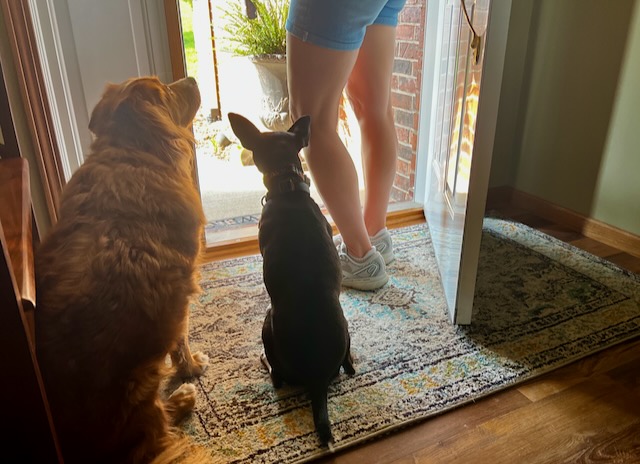1. Exercise – Because a dog’s naughty behavior is often the result of pent up frustration

It is important to remember that dogs have descended from wolves, predators that were on the move for many miles each day. Today’s companion dog no longer needs to hunt to survive, but they still need movement. Unfortunately, far too many dogs are lucky if they get even a short walk around the block each day.
Lack of exercise is one of the most frequent reasons dogs display problems like destructive chewing and nuisance barking. These behaviors are the result of pent-up energy and frustration. And let me point out that you are not off the hook just because “the dog has a big yard to play in.” How many dogs do you see exercising themselves in a productive way? A dog outside alone is more than likely running the fence line harassing the neighbors or digging holes in the flower bed than doing some calisthenics. 😉
If you’re thinking to yourself “My dog seems fine. He just lays around on the couch all day,” perhaps that is because he has no other choice. No one is exercising him and lethargy is a stress response similar to depression.
What can you do? Go outside and play with your dog. Fetch, tug, frisbee, or just take turns chasing the dog and the dog chasing you in that big yard. Spend time doing something together. When you go for a walk, make it interesting. Find a new route to explore. Or try alternating your pace by walking briskly, then slowly, and then break into a short jog. Add in a couple practice Sits and Downs to turn the tired old routine into an outing that works the dog’s mind and body. Then the nap on the couch is needed to refresh rather than just fill time because there is nothing else to do.
2. Rules – Because dogs thrive when they have some structure

Inserting structure into your dog’s daily routine will go a long way toward solving behavior problems. Having your dog Sit before you clip the leash on or before you put the food bowl down, is an opportunity to build better manners and exercise your dog’s brain. Teaching your dog to walk beside you nicely takes a little practice, but it goes a long way in teaching your dog to pay attention to you rather than yapping and lunging at every other dog they see.
What can you do? Get started by making small changes. Changing your dog’s behavior, starts by you changing yours first! Something as simple as walking past the dog and ignoring them when they are over excited can transform chaos into calmer greeting behaviors. Most changes are actually quite simple and don’t take a lot of time out of the day. For easy ideas on how to add more structure into your dog’s routine, download this Free Guide.
3. Optimal Health – Because behavior is influenced by how we feel
We know that our own behavior often depends on how we feel. And we know that how we feel is often related to what we eat. It is no surprise to have the jitters after too much caffeine, or a stomach ache from eating the wrong snack. When that happens, you simply don’t behave the same way as when you’re feeling healthy and in balance. Behavior is related to the food we use to fuel the body and brain cells. Dogs are no different. Unfortunately, they have little choice about the matter since we decide what goes in their food bowl.
It is important to recognize that any dog on a kibble (dry dog food) diet is eating a highly processed meal. Essentially, kibble is to dogs what cereal is to humans. Is cereal the worst possible food to eat? No, probably not. But what if we ate the same cereal for every meal, every day, for the rest of our lives? We would not accept that for our own health. Why do we tolerate that thinking for our dogs?
We can do better. And it doesn’t have to be complicated or time consuming! There are many foods that are beneficial and provide key nutrients. Something as simple as adding a few blueberries or veggies to the diet go a long way toward helping your pet fill in the nutrient void. But when you’re ready to go a step further, I’d encourage you to provide your dog with a fresh food diet.
More and more pet lovers are realizing the incredible benefits that come with feeding biologically appropriate foods. Fresh feeding may be a mindset shift if you’re unfamiliar with it, but there are lots of resources to support the transition. My introduction to feeding dogs a better diet came through meeting Wendy Volhard about twelve years ago. Wendy was my first mentor in the canine nutrition world, and while I’ve studied and listened to numerous experts since then, I’ve continued to use her formula as the foundation for my dog’s health. It is quick, easy, and ensures I’m doing it right.
You can learn about Volhard Diets by clicking here. If you have any questions, please feel free to reach out. I’d be happy to chat about my experience since I’ve seen the benefits firsthand.

Comments